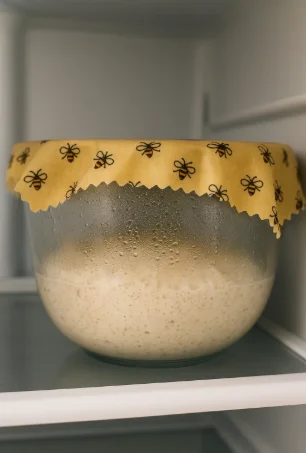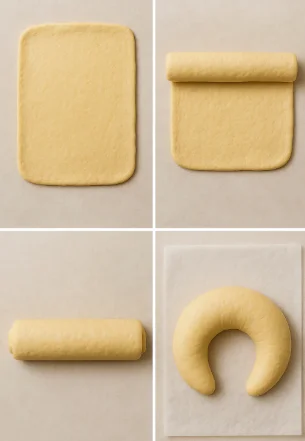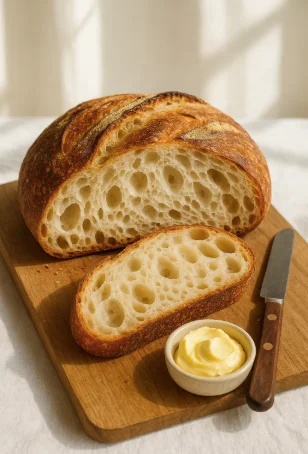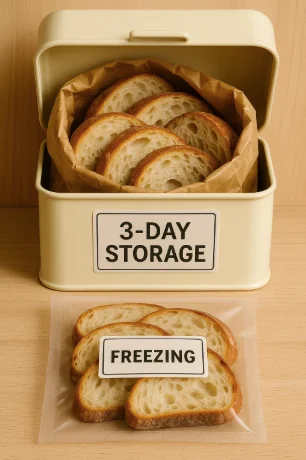Want to stay in your kitchen and enjoy bakery-quality bread with a buttery texture and vintage tang? This Sourdough Crescent Loaf Recipe is the answer. This bread blends art, science, and comfort food into one delicious bite. It is made using a natural starter, slow-fermented for rich depth, and shaped into a gorgeous crescent.
This guide explains how to make the Sourdough Crescent Loaf Recipe, from fermentation techniques to shaping, proving, and baking for a beautiful, crusty finish, regardless of your level of baking experience. Are you prepared to bake your masterpiece?
This Post Contain Affiliate Links
A Sourdough Crescent Loaf: What Is It?
A sourdough crescent loaf combines the typical sourdough fermentation methods with the shape of a crescent roll. A natural sourdough starter gives this bread its rise, while crescent-style folding or rolling gives it its shape, unlike airy crescent rolls produced with artificial yeast.
This bread is ideal for holiday settings, artisan-style sandwiches, or just slathering with butter. This loaf combines the best qualities of both worlds, featuring a crunchy crust, a soft center, and a tangy flavor.
You’ll Need These Ingredients

This is the list of ingredients you’ll need to make a handmade sourdough crescent loaf. Use only premium, organic ingredients for optimal results.
| Ingredient | Purpose | Substitution |
| 150g active sourdough starter | Natural leavening | None (can’t skip) |
| 400g bread flour | Structure & gluten | Use 50% whole wheat for a rustic version |
| 270g water (filtered) | Hydration | Slightly more/less, depending on flour |
| Slightly more/less, depending on the flour | Flavor | Kosher salt works too |
| 30g unsalted butter (softened) | Richness & softness | Vegan butter for dairy-free |
| 1 tsp honey (optional) | Enhances fermentation | Maple syrup for vegans |
Advice: Do you want a sourdough crescent bread that is vegan? Simply replace honey and butter with plant-based substitutes.
Detailed Instructions for Making a Sourdough Crescent Loaf Recipe
First, Turn On Your Starter

Four to six hours before baking, feed your natural sourdough starter. It should pass the float test, double in size, and have a somewhat fruity scent. A slow start results in a flat loaf.
Second, Combine The Dough
Combine the starter and water in a large bowl until the mixture becomes hazy. Stir in flour until shaggy. Give it 30 minutes to rest (autolyze) so that gluten can form naturally. Add the softened butter and salt after that. Stir thoroughly.
Step 3: Stretch/Fold & Bulk Fermentation

Leave the dough covered at room temperature for four to five hours. In this period:
- Every 30 minutes, perform three to four sets of stretches and folds.
- This makes sourdough bread more airy by fortifying the dough.
Step 4: Overnight Cold Fermentation

Move the dough to a container that has been lightly greased. Give it 12 to 16 hours to rest in the refrigerator. The flavor and structure are improved by this overnight sourdough fermentation.
Creating a Crescent Sourdough Loaf (Detailed Illustrations)

This bread’s form is what makes it so magical. Here is a step-by-step guide on creating a crescent sourdough loaf:
- Dust your surface with flour.
- Roll out the dough into a long rectangle or oval that is 14 inches.
- Roll tightly like a jelly roll, tucking the sides in.
- Gently bend the roll into a crescent shape.
- To taper, pinch the ends.
Pro Tip: Don’t worry if it’s not symmetrical if you want a characterful artisan sourdough crescent bread. Its rustic appearance adds to its allure.
Instructions for Final Proofing and Baking

Last Verification
Shaped dough should rest on a banneton or parchment for two to three hours at room temperature, or until it passes the poke test.
Using Steam to Bake Sourdough
- Use a Dutch oven to preheat the oven for 30 minutes to 475°F (245°C).
- Using a bread lame, gently score the loaf, using curves for visual appeal.
- Bake for 15 to 20 minutes uncovered, after 20 minutes covered.
For the first stage to have an open crust and a blistered exterior, steam is essential.
What Distinguishes Sourdough Crescent Loaf From Ordinary Sourdough?

In addition to being just ornamental, the crescent shape affects the bread’s baking process by increasing the crust’s surface area and textural contrast. It produces a crispy, highly caramelized top and a delicate, tangy interior when combined with natural fermentation.
In contrast to typical sourdough batards or boules, this loaf is:
- Slices for sandwiches are simpler.
- More striking in terms of appearance
- A combination of crescent roll craftsmanship and fermented dough processes
The Health Advantages of Fermenting Sourdough
In addition to being delicious, sourdough bread has more nutrients than regular white bread.
- Reduced gluten content makes it easier to digest.
- Rich in prebiotics for intestinal health
- glycemic index lower than that of white bread
- Increased mineral absorption as a result of phytate degradation
Thus, in comparison to white bread, this sourdough crescent loaf is healthier.
Typical Errors in Sourdough Baking and Shaping (And Solutions)
| Mistake | Cause | Fix |
| Dense loaf | Under-proofing or weak starter | Extend the bulk rise & ensure the starter is bubbly |
| Spread too wide | Overhydration or poor shaping | Reduce hydration slightly, tighten shaping |
| Pale crust | Not enough heat or steam | Use a Dutch oven + bake at 475°F |
| Flat rise | Cold dough or short final proof | Warm up dough gently before baking |
To troubleshoot like an expert, save these tips.
Crucial Ingredients for Handcrafted Sourdough Crescent Bread
A professional kitchen is not necessary, but these items can help:
- Digital scale (accuracy counts)
- Hands or a Danish dough whisk for combining
- A bench scraper for shaping
- Banneton basket (not required)
- Dutch oven and parchment paper
When making sourdough for the first time, start small. Before being fixated on artisan molding or scoring, master fermentation.
Serving Suggestions: How Does Sourdough Crescent Loaf Pair?

This bread can be used for a variety of purposes:
- Breakfast: is almond butter or avocado on toast.
- Lunch: BLT or gourmet grilled cheese
- Appetizer: Balsamic and olive oil-sliced
- Holiday table: Make a sourdough crescent loaf for Thanksgiving with herbs.
Do you want anything that’s in season? Try a cinnamon-and-raisin-topped sourdough crescent breakfast loaf.
How to Freeze and Store Crescent Loaf Sourdough

- Room Temperature: Keep for up to three days in a paper bag inside a bread box.
- Freeze: for up to two months after slicing and wrapping each one separately.
- Reheat: Warm the entire loaf for ten minutes at 350°F or toast frozen slices.
The fluffy inside and crusty outside are maintained with proper storage.
FAQs
Can I use whole wheat flour to create sourdough crescent loaves?
Yes. For a denser, nuttier loaf, use up to 50% whole wheat flour instead of bread flour. 5–10% more water should be consumed.
What causes the density of my sourdough crescent loaf?
It’s possible that your starter is inactive or that your dough is underproofed. Verify the strength of the starter and the timing of fermentation.
Can I make crescent bread with sourdough and active dry yeast?
Although it negates the benefit of natural fermentation, you can. For flavor and health reasons, stick with the beginning.
Is commercial yeast necessary to make a sourdough crescent loaf?
Absolutely. The great thing about sourdough is that, if your starter is robust, you don’t need commercial yeast.
Concluding Remarks: Prepare the Crescent, Savor the Enchantment
There is a certain satisfaction that comes from taking a warm, golden, crusty sourdough crescent loaf out of the oven. The crust’s shape, taste, and crackle are all labors of love that provide tenfold rewards.
This is the handcrafted Sourdough Crescent Loaf Recipe you’ve been searching for—part comfort meal, part artisan showpiece. Prepare to experience what real bread tastes like by following the instructions and having faith in the process.

Sourdough Crescent Loaf Recipe
Equipment
- 1 Digital scale
- 1 Mixing Bowl
- 1 Dutch oven
- 1 Bench scraper
- 1 Parchment paper
- 1 Lame or sharp knife
Ingredients
- 150 g Active sourdough starter
- 400 g Bread flour
- 270 g Filtered water
- 10 g Sea salt
- 30 g Unsalted butter
- 1 tsp Honey
Instructions
- Starter for FoodFour to six hours before using, feed your sourdough starter. It should pass the float test and be bubbly and lively.
- Combine the dough.In a large basin, combine starter and water. Add flour and stir until shaggy. Take a half-hour break (autolyze).
- Add salt and butter.To the dough, add the softened butter and salt. By hand, thoroughly mix until combined.
- Fold and Stretch Do three to four sets of stretch-and-folds every half hour for four to five hours at room temperature.
- Fermentation in the Cold: Spoon dough into a container. For overnight sourdough fermentation, place in the refrigerator for 12 to 16 hours.





